|
Limitar tu búsqueda
[+–] Editorial
[+–] Fecha
[+–] Formato
[+–] Idioma
[+–] Tipo de documento
[+–] Tipo de recurso
|

|
|
Protecting vulnerable children from uninsured risks: adapting conditional cash transfer programs to provide broader safety nets
Conditional cash transfer (CCT) programs have proved to be effective in inducing chronic poor households to invest in the human capital of their children while helping reduce poverty. They have also protected child human capital from the shocks that affect these households. In this paper, we argue that many non-poor households exposed to uninsured shocks have to use children as risk coping...
|
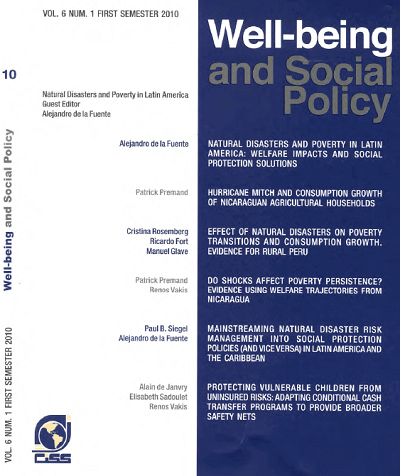
|
|
|
|

|
|
Mainstreaming natural disaster risk management into social protection policies (and vice versa) in Latina America and the Caribbean
This paper presents and applies the social risk management (SRM) conceptual framework to examine links between disaster risk, hazards, vulnerability, risk management, and social protection (SP). The paper makes the case that it is important to mainstream social protection policies into the disaster risk management (DRM) agenda and, vice versa as a means to improve household and community...
|
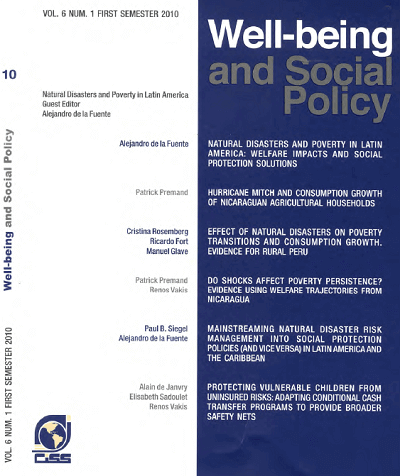
|
|
|
|

|
|
Effect of natural disasters on poverty transitions and consumption growth. Evidence for rural Peru
Natural hazards, an increasingly important phenomenon, have a direct impact at regional and household level. The growing incidence and persistence of natural events are strongly linked to increasing vulnerability of households and communities in developing countries. Previous socioeconomic vulnerabilities may exacerbate the impact of a specific event, making more difficult the process of...
|
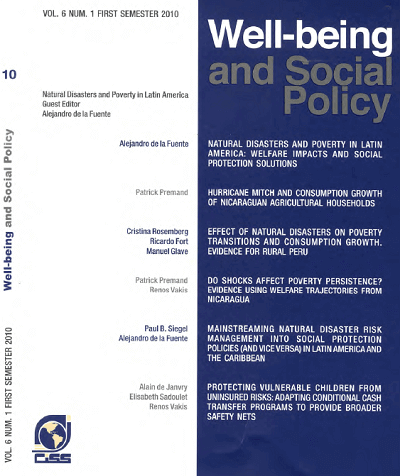
|
|
|
|

|
|
Hurricane Mitch and consumption growth of nicaraguan agricultural households
There is little micro-evidence on the persistence of natural disasters' welfare impacts. This paper assesses the effect of Hurricane Mitch on consumption of Nicaraguan agricultura) households. Mitch occurred in October 1998. Pre-post data is obtained from a nationally representative panel collected in 1998 and 2001. An additional survey was fielded in 1999 for households from the panel affected...
|
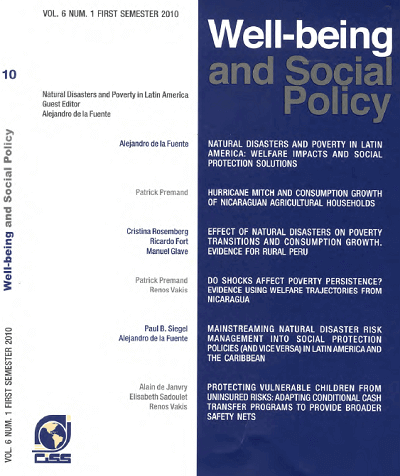
|
|
|
|

|
|
Natural disasters and poverty in Latin America: welfare impacts and social protection solutions
The Inter-American Conference on Social Security (CISS) and the United Nations Development Programme (UNDP) Office in Mexico jointly organized the conference “Natural Disasters in Latin America: Welfare Impacts and Social Protection Solutions” held in Mexico City in January 2010. The main objectives of the conference were to improve the understanding of (i) how natural disasters affect...
|
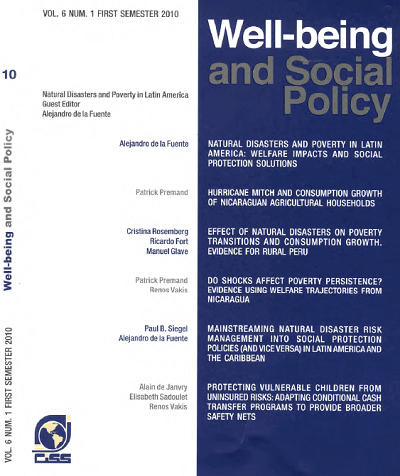
|
|
|
|

|
|
Book review. Informe de evaluación de la política de desarrollo social en México 2008, CONEVAL
The Evaluation Report on Social Development Policy in Mexico was published by the National Council for Social Development Policy Evaluation (CONEVAL) in 2008. The Council is one of the constituting elements of the new institutional framework to evaluate the public sector performance, particularly social development policies that were put in place mostly during the first decade of this century....
|

|
|
|
|

|
|
Do shocks affect poverty persistance? Evidence using welfare trajectories from Nicaragua
Shocks are often primarily associated with downward mobility or short-term movements in and out of poverty. However, households at the bottom of the welfare distribution are likely to face the most constraints to access insurance mechanisms. In this paper, we consider whether shocks directly affect poverty persistence. In order to analyze the impact of shocks on households’ welfare path over time...
|

|
|
|
|

|
|
Social security pensions and retirement decisions in Mexico
Using Mexican cohort data for 1991-2000 this article examines the relationship between retirement decisions —the transition from work to labor market inactivity— and social security (contributive) pensions in less developed countries. The available large time series also makes possible to examine how a financial crisis that took place in 1995 has affected retirement incentives. In most Latin...
|

|
|
|
|

|
|
A simple poverty scorecard for Mexico
This study uses Mexico's 2008 National Household Survey of Income and Expenditure to I construct an easy-to-use scorecard that estimates the likelihood that a household has income below a given poverty line. The scorecard uses ten simple indicators that field workers can quickly collect and verify. Poverty scores can be computed on paper in the field in about five to ten minutes. The scorecard's...
|
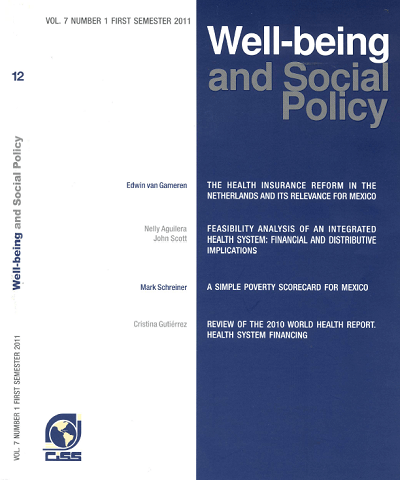
|
|
|
|

|
|
Introduction (On the issue of social capital that is addressed in this issue of the journal)
In recent decades, interest has increased in identifying, estimating and linking social capital to a variety of well-being variables in which the production of certain benefits or performance is key. Research has involved the confluence of several disciplines: economics, sociology, anthropology and psychology, to name a few. Although consensus on the definition of a single indicator for measuring...
|
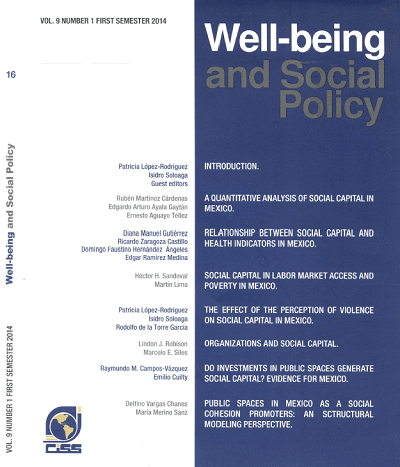
|
|
|
|

|
|
Do investments in public spaces generate social capital? Evidence for Mexico
The formation of social capital is critical for developing countries. This paper investigates the effects of attempts to recover public spaces in marginalized areas of Mexico. The effects are estimated through balancing in the propensity scores. We focus on the results of perception of safety, support and social capital. When efforts are made to recover public spaces, the perception of safety...
|

|
|
|
|

|
|
Organizations and social capital
An organization is a group of persons who satisfy established membership requirement and whose form and function are generally acknowledged. An organization's membership requirements may be based on inherited or earned traits. Organizations exist because they provide a setting in which members with similar traits can meet their physical and their socioemotional needs. As the relative importance...
|
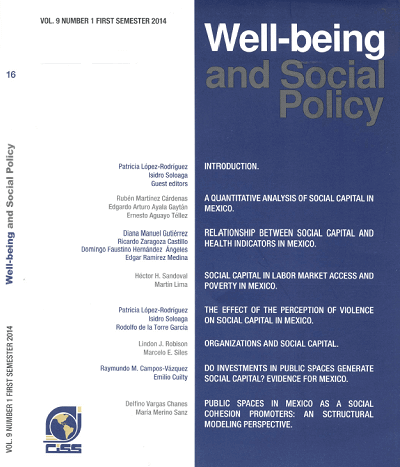
|
|
|
|

|
|
The effect of the perception of violence on social capital in Mexico
Increasing levels of violence in Mexico, which have the potential to damage the very fabric of 1 society, as well as impact key economic variables, led us to analyze the effect that changes in the perception of violence had on social capital fluctuations (including associative capital) between 2006 and 2011. This was a period in which an anti-violence and anti-organized crime policy was launched...
|
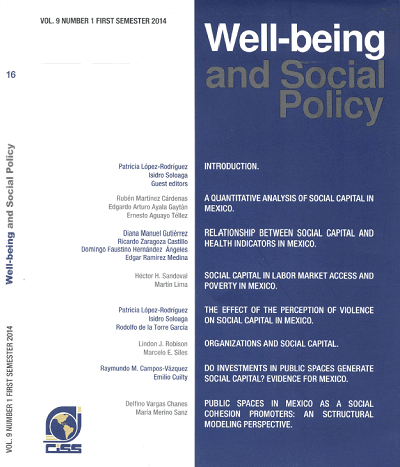
|
|
|
|

|
|
Social capital in labor market access and poverty in Mexico
Social capital, defined as the set of social networks that a person has in order to obtain benefits, is used by the population as a mechanism for providing resources, to cushion shocks in consumption and to obtain information on available employment opportunities. This study employs a logistic model to characterize the manner in which people access the labor market in Mexico through the use of...
|

|
|
|
|

|
|
Relationship between social capital and health indicators in Mexico
This study analyzes the relationship between social capital types and access to health services in Mexico. To this end, access to healthcare data from the 2006 ENCASU and 2011 ENCAS was validated using 2006 and 2012 ENSANU results. Indicators were found to be consistent. A statistical analysis of the distribution of social capital and health indicators by region, as well as by rural or urban area...
|
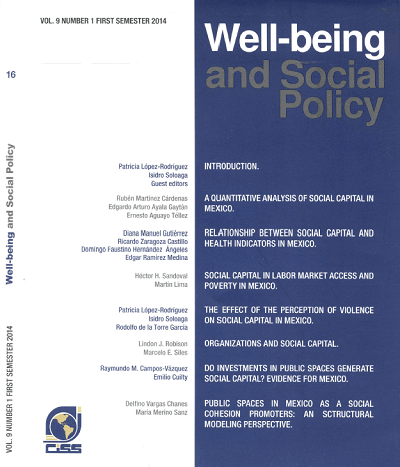
|
|
|
|

|
|
A quantitative analysis of social capital in Mexico
Se ha relacionado el capital social a la eficiencia en los mercados (Arrow, 1972), al refuerzo del contrato (Durlauf y Fafchamps, 2004) y en general al desarrollo y bienestar (Keefer y Knack 1997; Putnam 2000; Knack y Zak 2003). En el presente trabajo hemos investigado los determinantes del capital social empíricamente, centrándose en tres medidas comunes aproximadas de este: dos ligadas a la...
|

|
|
|
|

|
|
MSMES in Costa Rica: Chronicle of their poor integration in times of accelerated international integration
El presente documento, está centrado en las Mipyme y en las políticas públicas para su fomento en la economía costarricense. El análisis, se hace a partir de un enfoque alternativo de clasificación de las actividades económicas, el cual permite precisar con mayor detalle las desigualdades entre las actividades tradicionales de amplia trayectoria en la economía, de aquellas actividades que han...
|

|
|
|
|

|
|
Promised and actual benefits in mexican social security fot rhe transtion generation
Este artículo presenta un conjunto de mediciones de los costos y beneficios reales del plan general de retiro por jubilación proporcionado a los ciudadanos por parte del Sistema Mexicano de Pensiones (SMP), que son necesarias para evaluar las decisiones de los trabajadores en cuanto a la contribución a la seguridad social (es decir, trabajar en el sector formal) y al retiro. El SMP ofrece dos...
|

|
|
|
|

|
|
Analysis of the use of financial services by companies in Mexico: What does the 2009 Economic Census tell us?
We present a descriptive analysis of the results of Mexico's 2009 Economic Census regarding the use of bank credit and accounts by productive entities (companies). INEGI was requested to prepare a set of statistics regarding various company characteristics that are relevant to the decisions made by institutions offering banking services. Information was grouped according to company size and to...
|
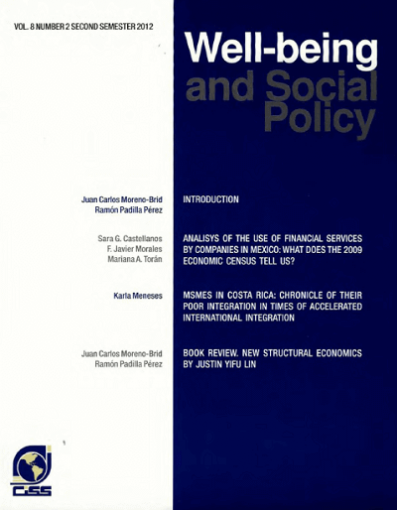
|
|
|
|

|
|
Introduction (On the issues addressed by this issue of the journal)
Micro and small-sized enterprises (MSE) have a central role in economic development in Latin America given their large contribution to employment generation, their share in the total number of firms and, to a lesser extent, their contribution to gross domestic product. Yet, their production is mainly oriented to the domestic market and they are characterized by an increasing productivity gap with...
|
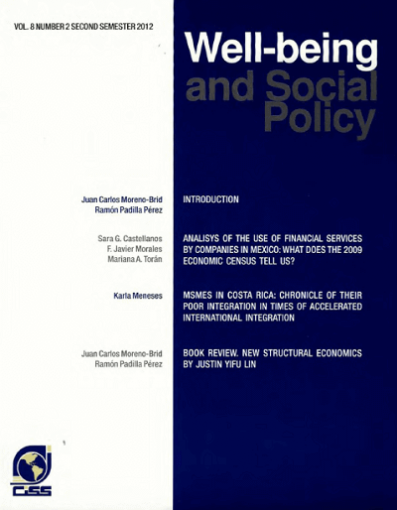
|
|
|
|
|